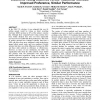Free Online Productivity Tools
i2Speak
i2Symbol
i2OCR
iTex2Img
iWeb2Print
iWeb2Shot
i2Type
iPdf2Split
iPdf2Merge
i2Bopomofo
i2Arabic
i2Style
i2Image
i2PDF
iLatex2Rtf
Sci2ools
CHI
2008
ACM
2008
ACM
Electronic voting machines versus traditional methods: improved preference, similar performance
In the 2006 U.S. election, it was estimated that over 66 million people would be voting on direct recording electronic (DRE) systems in 34% of the nation's counties [8]. Although these computer-based voting systems have been widely adopted, they have not been empirically proven to be more usable than their predecessors. The series of studies reported here compares usability data from a DRE with those from more traditional voting technologies (paper ballots, punch cards, and lever machines). Results indicate that there were little differences between the DRE and these older methods in efficiency or effectiveness. However, in terms of user satisfaction, the DRE was significantly better than the older methods. Paper ballots also perform well, but participants were much more satisfied with their experiences voting on the DRE. The disconnect between subjective and objective usability has potential policy ramifications. Author Keywords Voting, electronic voting, DRE, usability, prefere...
CHI 2008 | Computer-based Voting Systems | Electronic Voting | Human Computer Interaction | Traditional Voting Technologies |
| Added | 30 Nov 2009 |
| Updated | 30 Nov 2009 |
| Type | Conference |
| Year | 2008 |
| Where | CHI |
| Authors | Sarah P. Everett, Kristen K. Greene, Michael D. Byrne, Dan S. Wallach, Kyle Derr, Daniel Sandler, Ted Torous |
Comments (0)

